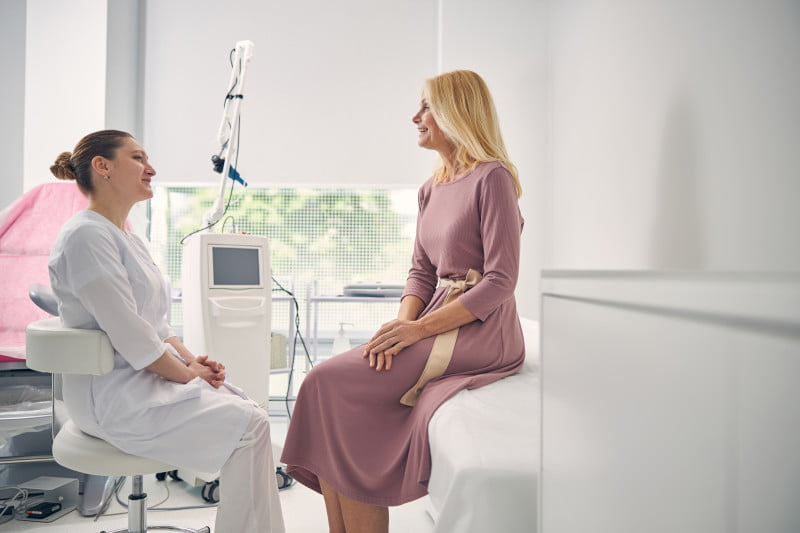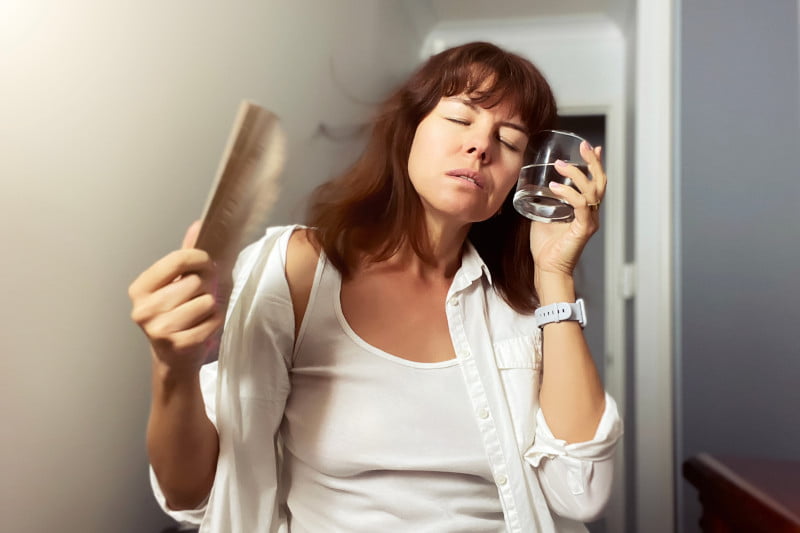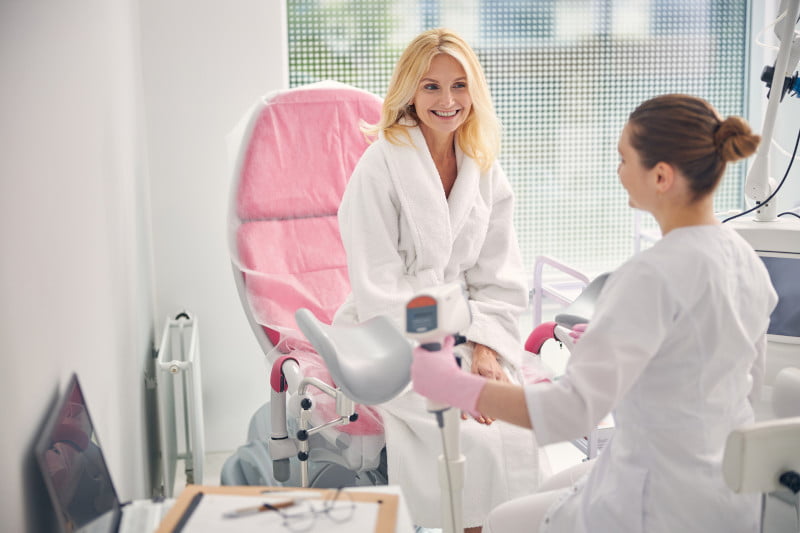Testosterone is likely the most popular of all the male hormones, but its well-known name isn't quite accurate.
Despite being known as the "male hormone," testosterone is also found in women - in smaller amounts.
Like men, testosterone levels in women need to be balanced to maintain their health; otherwise, it could lead to adverse conditions that may affect their quality of life.
Either abnormally low or abnormally high testosterone levels can cause issues. Read on to learn more.
What Is Testosterone and What Does It Do for a Woman?
Testosterone is an androgen present in men and women, but men typically have much higher levels of testosterone than women, making it more well-known as "the male hormone."
Most testosterone in both men and women can be found circulating in the blood. This testosterone is bound to the body's sex hormone-binding globulin or SHBG(1).


Testosterone is vital for producing new blood cells, developing body hair, and balancing mood in men.
Meanwhile, testosterone in women contributes to the health of their sexual organs and fertility(2).
Testosterone also helps keep their libido active.
Both men and women typically produce less testosterone as they age, leading to numerous health issues.
What Are the Normal T-Levels in Females?
Normal testosterone levels for women will differ depending on their age, but they should generally be much lower than male testosterone levels.


Women aged 19 years and above average at 15-70 nanograms per deciliter ng/dl of testosterone(3).
Anything outside of this range could be an indication of an undiagnosed medical issue or disorder. It’s recommended that women regularly check their sex hormone levels to be in optimal health.
What Produces Testosterone in Females?
Similar to men, women have female adrenal glands that produce testosterone.
The adrenal glands and ovaries also secrete the male sex hormone DHEA and the female hormones estrogen and progesterone.


Women experience high testosterone levels around the beginning of puberty, which quickly lowers and plateaus as their bodies convert it into estrogen and other female reproductive hormones.
Puberty progresses into the development of secondary sexual characteristics like the growth of pubic hair and the development of breasts.
In rare cases where women have high testosterone levels, they will exhibit the physical characteristics of men, like developing a much deeper voice and a large increase in muscle.
Do Testosterone Levels Decrease as Women Age?
It's normal for testosterone levels in women to go down with age. This is a common effect of menopause.
A woman's testosterone level will fluctuate with age and even the time of day, but it typically occurs between the ages of 40-55.


If you are experiencing the symptoms of diminished testosterone levels, your doctor may take a blood sample to conduct tests.
Your doctor may ask for other symptoms before they proceed to ask for a blood sample.
What Are the Symptoms of Low Testosterone in Women & What Causes It?
Testosterone interacts with a woman's other reproductive hormones, like estrogen and progesterone, to keep them physically healthy.


Having low testosterone can result in the following issues(4):
- Vaginal dryness
- Difficulty producing new blood cells
- Difficulty sleeping
- Weakened libido and diminished sexual satisfaction
- Irregular menstrual cycles
Early menopause, weakened or surgically removed ovaries, and aging are the most common causes of lowered testosterone levels in women.
How to Support Testosterone Levels After Menopause
Post-menopausal women experiencing the effects of lowered testosterone can take oral contraceptives or creams through a prescription.
This treatment is expensive and won't be permanent, but it can help provide its users with energy and more endurance.


Another potential treatment method is to identify other possible sources of lowered testosterone and address them.
These may include:
- Getting enough sleep
- Eating a balanced diet
- Getting enough physical exercise
Why Do Testosterone Levels Rise in Women?
Women who take blood tests to determine their levels of testosterone may find that their test results show too much testosterone in their system.
While excess testosterone can be the result of menopause, it could also be a symptom of imbalanced hormone levels brought on by multiple disorders or an underlying medical condition like CAH or PCOS.


Here are the details of CAH and PCOS:
- Congenital Adrenal Hyperplasia (CAH) - "Congenital adrenal hyperplasia"(5) (CAH) refers to multiple issues that may arise because of your body's adrenal glands. These health issues can range from mild to severe, but this disorder commonly produces too little cortisol in your body.
- Polycystic Ovary Syndrome (PCOS) - "Polycystic ovary syndrome"(6) (PCOS) can cause high testosterone levels in women. It can also cause cancer and diabetes. It's possible to improve PCOS symptoms by exercising regularly and losing a small amount of weight.
Should Women Seek Treatment for Abnormal Testosterone Levels?
Anything from menopause to excessive athletic training can cause a woman's testosterone levels to become too low or too high.


Unless these conditions negatively affect your life, you shouldn't seek to ask for Testosterone Replacement Therapy(1) as there isn't enough research into testosterone therapy yet.
Before asking your doctor to take a blood test, identify and address the other possible sources of your lowered testosterone levels first.
Frequently Asked Questions (FAQs)
Learn more about testosterone levels in women here!
What Is Average Testosterone Level by Age in Females?
At 9 years of age, women will have 7-20 nanograms per deciliter ng/dL of testosterone. This will increase slightly to 7-44 ng/dL once they hit 10 and go up again to less than 75 ng/dL at 12. Once they turn 17, their levels of testosterone will be between 20-75 nanograms per decilitre. It'll plateau at 8-60 ng/dL from 19 onwards.
How Much Higher Is Male Testosterone Hormone Than Female?
As one of the primary male hormones, testosterone is typically much higher in men than in women. This is due in part to which organs produce testosterone. While both men and women rely on the adrenal glands to produce testosterone, men will produce 30 times as much of this sex hormone as women, regardless of age.
When Do You Have a Testosterone Imbalance?
Low testosterone levels in women and their associated symptoms are similar to low test levels in men. They include a reduction in bone mass and muscle mass, unexplained bouts of fatigue, a significantly lowered libido, and unexplained weight gain. Beyond the physical signs, lowered testosterone can cause mood swings and issues with sleeping.
What Are Ways We Can Increase Testosterone Levels and Sex Hormones Naturally in Women?
If your adrenal glands aren't producing enough testosterone, you can support it by increasing your magnesium and zinc intake. These vital minerals will help in building muscle and are helpful for gaining high testosterone. Outside of vitamins, eat a balanced and nutritious diet and get regular physical exercise to maintain a healthy weight.
Conclusion
Testosterone is just as vital for the female body as it is for men.
Maintaining a healthy balance of hormones and proteins like sex hormone-binding-globulin is essential for both men and women.
If any of the symptoms presented here apply to you, work with your doctor to address and identify any possible causes before moving on to testosterone treatment.


- Davis, S. “Testosterone deficiency in women.” The Journal of reproductive medicine vol. 46,3 Suppl (2001): 291-6.↩↩
- Rådestad, Angelique Flöter. “Testosteron värdefullt för kvinnor--brist kan behöva substitueras. Betydelse för sexualitet, metabolism och psykiskt välbefinnande” [Testosterone valuable for women--deficiency might require substitution. The significance for sexuality, metabolism and mental well-being]. Lakartidningen vol. 103,9 (2006): 634-6, 638-9.↩
- Davis, S, and J Tran. “What are "normal" testosterone levels for women?.” The Journal of clinical endocrinology and metabolism vol. 86,4 (2001): 1842-4. doi:10.1210/jcem.86.4.7436-10↩
- Davis, Susan R, and Sarah Wahlin-Jacobsen. “Testosterone in women--the clinical significance.” The lancet. Diabetes & endocrinology vol. 3,12 (2015): 980-92. doi:10.1016/S2213-8587(15)00284-3↩
- Momodu, Ifeanyi I., et al. “Congenital Adrenal Hyperplasia.” StatPearls, StatPearls Publishing, 18 July 2022.↩
- Ndefo, Uche Anadu et al. “Polycystic ovary syndrome: a review of treatment options with a focus on pharmacological approaches.” P & T : a peer-reviewed journal for formulary management vol. 38,6 (2013): 336-55.↩
